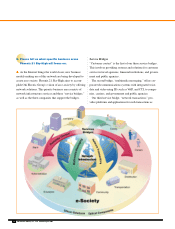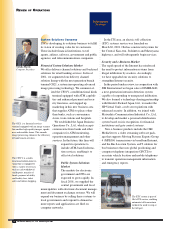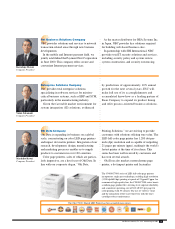Oki 2001 Annual Report Download - page 18
Download and view the complete annual report
Please find page 18 of the 2001 Oki annual report below. You can navigate through the pages in the report by either clicking on the pages listed below, or by using the keyword search tool below to find specific information within the annual report.
Oki Electric Industry Co., Ltd. Annual Report 2001
16
Operating Results
Despite low personal consumption and harsh economic condi-
tions, the corporate sector in particular began to show positive
signs in the first half of fiscal 2000, and overall mild economic
improvement continued in fiscal 2001, ended March 31, 2001.
Since the end of the period, however, the Asian and U.S. eco-
nomic slowdown has effectively halted economic improvement,
bringing the economy to a standstill.
Oki’s business environment is going through dramatic
changes, with corporate reorganization in the financial and tele-
communications industries and changes in business models
triggered by global competition and the IT revolution. In this
environment, Oki smoothly and successfully implemented its
Phoenix 21 plan, established in fiscal 1998, and the Group
worked together to achieve its vision of becoming a network
solutions company with stable profits.
Net sales grew ¥70,474 million, or 10.5%, to ¥740,250 mil-
lion. Operating income more than doubled, to ¥28,314 million,
from ¥13,804 million in the previous period, owing to
continuous efforts to cut costs.
In fiscal 2001, the Oki Group reclassified its business into the
following four segments: telecommunications systems, informa-
tion systems, electronic devices and other. The following
segment information includes business transactions between
the segments.
Although IT-related investment continued to be slow, demand
for ATMs contributed to sales of ¥367,492 million in the infor-
mation systems segment. Operating income was ¥1,485 million.
In the telecommunications systems segment, construction of
next-generation telecommunications networks for carriers and
capital investment in multimedia telecommunications networks
on the part of general companies was quite active, leading to
sales totaling ¥169,877 million, with operating income amount-
ing to ¥7,200 million. In the electronic devices segment, sales of
logic and foundry systems in particular were favorable, and
memory prices were stable, bringing sales to ¥199,306 million.
Operating income was ¥29,886 million. Other sales amounted to
¥79,561 million, with operating income totaling ¥1,246 million.
Domestic sales rose ¥49,106 million, or 7.8%, to ¥678,935
million, primarily owing to higher sales of electronic devices,
such as logic and system LSI circuits. Operating income jumped
¥11,801 million, or 80.5%, to ¥26,453.
In North America, sales increased ¥11,052 million, or 14.9%,
to ¥85,053 million, owing to the weaker yen and growth in sales
of electronic devices. The slump in the market for dot impact
printers, however, was worse than expected, and operating losses
improved only slightly, from a loss of ¥1,230 million in fiscal
2000 to a loss of ¥111 million.
In other regions, sales grew ¥26,445 million, or 23.7%, to
¥137,887 million. Operating income jumped ¥782 million, or
48.7%, to ¥2,388 million.
On a year-end average basis, net sales per employee reached
¥28.9 million, an increase from ¥27.4 million in fiscal 2000 and
¥28.4 million in fiscal 1999. Total asset turnover was 1.0 times,
as opposed to 0.87 times in fiscal 2000 and 0.82 times in fiscal
1999. Cost of sales increased 9.7%, to ¥563,368 million. The
cost of sales ratio improved to 76.1%, from 76.7% in fiscal 2000
and 81.9% in fiscal 1999. Gross profit jumped 13.1%, to
¥176,882 million.
Selling, general and administrative (SG&A) expenses rose
4.2%, to ¥148,567 million, and amounted to 20.1% of net sales,
an improvement from 21.3% in fiscal 2000 and 23.8% in fiscal
1999.
R&D expenses (included within cost of sales and SG&A
expenses) totaled ¥29,842 million, a 1.13% increase from the
previous period.
Other expenses exceeded other income by ¥10,008 million, up
from ¥7,288 million in the previous term. Interest expense was
¥10,426 million, down from ¥12,291 million in fiscal 2000,
mainly owing to a reduction of interest-bearing debt. In fiscal
2001, as a result of the weaker yen, the Group recorded a
foreign exchange gain of ¥1,881 million, compared with an
exchange loss of ¥5,030 million in fiscal 2000. In fiscal 2001,
new accounting standards for retirement benefits were intro-
duced in Japan. Other non-operating expenses included
amortization costs of transitional obligations for employees’
retirement benefits of a consolidated subsidiary, which decided
to amortize obligations over one fiscal year. Such amortization
expenses for other consolidated subsidiaries and the Company
are included in operating expenses. Please refer to note 7 on
page 24 of the notes to the consolidated financial statements for
details.
Income before income taxes, minority interests and equity in
earnings of affiliates totaled ¥18,306 million, an increase from
¥6,515 million in the previous period. After incurring income
FINANCIAL REVIEW
























